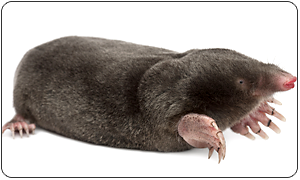Learn More About Moles

Did You Know???
Mole blood contains a "super-hemoglobin" protein that greatly enhances their carbon dioxide-carrying capacity enabling them to breathe in a low oxygen environment.Moles are mostly subterranean because that's where their food is. We were in a (bone dry) yard doing a job one summer day and noticed a live mole above ground. The only explanation I could come up with was that there was no food below because it was too dry. He turned out to be a surprisingly easy catch.
Moles have an interesting edge on their prey in which their saliva contains a toxin that paralyzes earth worms so that they can store them live for later consumption.
There are three species of moles in Washington. The Townsend Mole is the largest measuring in at a length of eight to nine inches and found west of the cascade mountains. The Pacific Mole, also known as the coast mole but smaller at a length of six to seven inches and found in wooded habitats. The Shrew Mole is the smallest at a length of four to five inches and more commonly active above ground. Definitely a more "yard friendly" fellow.
Moles mate from late winter to early summer producing a single litter of three to five young with a maximum life span ranging from four to six years. Our season generally begins by June 1st and doesn't begin to slow until around October depending fall/winter conditions. During the winter months when it's colder they dig deeper down because their food source does the same thing for warmth. We have had people tell us that they have discovered mole hills under their house. Althoueh there is not much of a food source there it is warmer.
